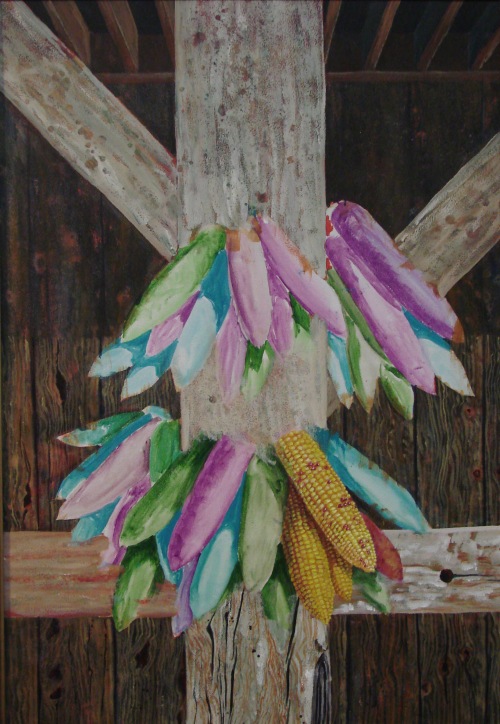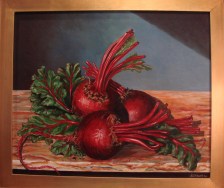Paint Process: Thirty Seven Ears Rev.5-3-13
Ground: Masonite panel
Lesson 2
The first lesson covered the rough sketch, finished drawing, and transferring the drawing to the panel. In this lesson we will begin the under painting.
All this painting was done with the panel flat on the work table. This allows better control of the washes and other methods I used throughout the painting. I generally use one brush for the entire painting. I prefer a Loew-Cornell 720 Ultra Round, #12. The washes for the rear wall, beams and ears of corn were done with this brush. To begin the painting I used Ouinacridone Red-orange for the background wall, a thin wash of Permanent Blue Light for the beams, and Burnt Sienna for the cast shadows. These are rather thin washes with some of the white ground showing through.
A wash of Prussian Blue was used on the six sections of wall. I did one section at a time by applying the wash and leaving some of the Ouinacridone Red-orange showing through. Right after the Prussian Blue wash was applied, and before it gets too dry, I use my fingertips to flick drops of soapy water onto the damp blue in a random pattern. I wait until the soapy water softens the damp blue, then I blot the section with paper towels to remove some of the blue. I then dry the surface with a hair drier to speed things up.
To under paint the corn, I used a thin wash of the contrasting color of the finished corn. Violet for the yellow corn. Hookers Green for the red corn, and permanent Blue Light for the orange corn. I indicate some of the cast shadows at this time by using a stronger wash of color. The final colors of the corn and the positions of the corn changed slightly as I made adjustments throughout the process. At this point, I started the color map for the painting as described in the first lesson.
Using the same brush, I added a second wash of Prussian Blue over the wall and flicked more soapy water on the surface, then blotted some off before it dried. I put a wash of Burnt Sienna over all of the posts and beams, and did the soapy water-blotting method on these. This was followed by applying some indication of wood grain with thin Prussian Blue. I added some floor joists behind the beams at the top of the painting. This gives some depth to the picture and served as the reason for the cast shadow at the top of the beam and on the wall.
I began adding wood grain on the lower half of the wall using thin lines of Yellow Ocher, Burnt Sienna, Raw Sienna and a little white. I went over the grain of the wood several times, adding swirls and knots in a random pattern. I placed some gaps between the boards using Prussian Blue, Hookers Green Deep and Ouinacridone Red-orange (I never use black or Payne’s Gray). I didn’t paint wood grain on the top section of the wall.
I considered the back wall, floor joist and beams as “supporting actors” in the image I’m trying to create. I save the finer, detailed work for the “star” of the show, the corn. I consider all this work thus far as under painting. Using opposite colors, thin washes, wetting damp paint and blotting are some of the methods I use. The hair dryer speeds up the drying process and using rags, paper towels, and crumpled aluminum foil can create an interesting effect in any painting.
I added the white wash and some details to the beams, experimenting with the lower part of the post first. I used White, Burnt Umber and a touch of Hookers Green Deep to make a soft, dull grey. I used the side of the brush to apply this mixture. I loaded the brush with moderately dry paint, held the brush almost parallel with the surface, and dragged the paint over the surface of the posts. The tiny peaks formed by the rolled geso pick off the paint from the brush. I also rotate the brush slightly to expose more paint to the surface. As soon as I apply the paint to one area, I splatter it with soapy water and daub the damp paint with a paper towel. The left, horizontal rail has one thin coat of White with some broken color. The top left and center post has two applications of paint and daubing and the bottom of the post has some cracks, wood grain and worm holes added.
I started experimenting by painting the kernels on a couple of ears. In the next lesson I explain how I used a Grumbacher #2 Round Liner brush to apply between five and ten coats of thin paint to each kernel of corn.
Summary:
- Working with the panel flat helps control paint flow with the washes.
- Under paint major areas with contrasting washes of color.
- Start the color map at this point.
- Indicate cast shadows with stronger washes.
- Flick soapy water on each section before it dries completely.
- Blot these drops of water with crumpled paper towels.
- Continue adding thin washes, wetting and blotting as needed.
- Build up details with washes, dry brushing and wet-blot as needed.
- Spend less time on secondary areas (the “supporting actors”) and more time on the ears of corn (the “stars”) of the image.
Next lesson: Laying out the rows of kernels, building the illusion of domed kernels, highlights and cast shadows.






